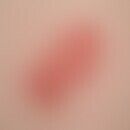Synonym(s)
HistoryThis section has been translated automatically.
DefinitionThis section has been translated automatically.
Controversial, apparently congenital, very rare, eminently chronic, solitary epidermal differentiation disorder of the skin with the following clinical characteristics: atrophic, circumscripter (sharply defined, as if punched out), 0.2-3.0 cm large, less symptomatic red spot, which occurs predominantly on the palmar and less frequently on the plantar skin of the groin.
You might also be interested in
EtiopathogenesisThis section has been translated automatically.
Unexplained; apparently a genetically induced circumscript keratinization defect with consecutive loss of keratinocyte adhesiveness occurs.
ManifestationThis section has been translated automatically.
LocalizationThis section has been translated automatically.
Predominantly the ball of the thumb, but also other parts of the palm and, more rarely, the sole of the foot.
ClinicThis section has been translated automatically.
HistologyThis section has been translated automatically.
Circumscripter, like punched out appearing thinned out orthokeratotic corneal layer. Regular-looking epidermis with a slightly thinned str. granulosum; low superficial, non-specific dermal infiltrate. No cornoid lamella, no cell atypia.
Differential diagnosisThis section has been translated automatically.
TherapyThis section has been translated automatically.
Progression/forecastThis section has been translated automatically.
LiteratureThis section has been translated automatically.
- Erkek E et al (2014) Circumscribed acral hypokeratosis: a report of 2 cases and a brief review of the literature. Cutis 93: 97-101
- Nguyen JV et al (2013) Dermatopathology diagnosis. Circumscribed acral hypokeratosis. Cutis 91:19-20
- Obermoser G, Zelger B (2003) "Multifocal" circumscribed palmar hypokeratosis: malformation or not? J Am Acad Dermatol 49: 1197-1198
- Pérez A et al (2002) Circumscribed palmar or plantar hypokeratosis: a distinctive epidermal malformation of the palms and soles. J Am Acad Dermatol 47: 1197
- Rutten A et al (2004) Circumscribed acral hypokeratosis. dermatologist 55: 1060-1063
Incoming links (1)
Circumscribed acral hypokeratosis;Disclaimer
Please ask your physician for a reliable diagnosis. This website is only meant as a reference.




